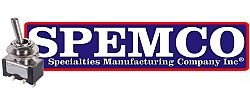Single Pole Triple Throw, Triple Pole Single Throw, SPST, DPDT, etc. How to tell the difference
Posted by Katie Rose on Aug 18th 2015
Many people believe that the word "poles" when used for circuit breakers or switches refers to how many terminals are on the bottom. While it may be a helpful way to determine how many poles the product is, it is NOT the definition.
A Pole simply means how many circuits the product controls. Single Pole controls one circuit, a double pole controls two separate circuits within one product and so on.
The word "throw" simply refers to how many ON positions the switch has. So if you have a triple throw switch it has 3 on positions.
SPST simply mean single pole, single throw. The product controls one circuit with one On position. SPDT means that it is a single pole double throw which means it has two ON positions. This can be a variety of circuitry however. It can be an On-On switch or On-Off-On.
DPST again means it controls two separate circuits but it only has one On position. DPDT means it has two on positions and can be configured above the same as a single pole can be.
3P usually indicates three poles, sometimes if it is a triple throw meaning 3 on positions it can be labeled for example as : SP3T or SPTT.
4P again means 4 poles. This is used as short hand in the industry but can be confusing to a layperson when trying to figure out what they have.
For Switches:
SPST or single pole single throw (with no lamps) usually has 2 terminals.
SPDT or single pole double throw (with no lamps) usually has 3 terminals.
DPST or double pole single throw (with no lamps) usually has 4 terminals.
DPDT or double pole double throw (with no lamps) usually has 6 terminals.
When you add lamps it depends on whether they are dependent or independent. As a refresher a dependent lamp means it is only lit up when the switch is in use. An independent lamp will remain lit even when the switch is not in use as long as power is given to it. Such is the case in many boat panels.
When you have a dependent lamp it adds one extra terminal to the switch terminal configuration. So for example a SPST switch with a dependent lamp will have 3 terminals. However the terminal will be on the opposite side of the switch so it is easy to tell the difference between a SPDT which has all three terminals in a row on the same side.
If you have an independent lamp it will add 2 terminals to the switch terminal configuration. So a SPST with an independent lamp will have 5 terminals and so on.
Here is a link to our Switches 101 http://spemco.com/switches-101
It may seem confusing but that is why our Spemco Sales team is here to help. Unlike other distributors we can help you figure out what you need even without a part number. We may ask how many terminals are on the bottom of the switch and where they are and this information can help us determine what product you may have or need.
When in doubt you can always contact one of them to get information or for any kind of assistance needed to help you get exactly what you want. They are knowledgeable and here to help, with or without a part number. Just another great reason to shop at Spemco!
